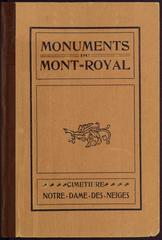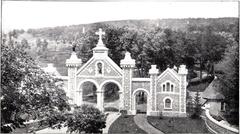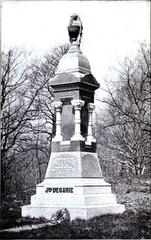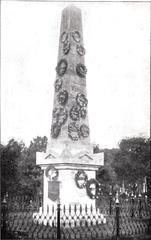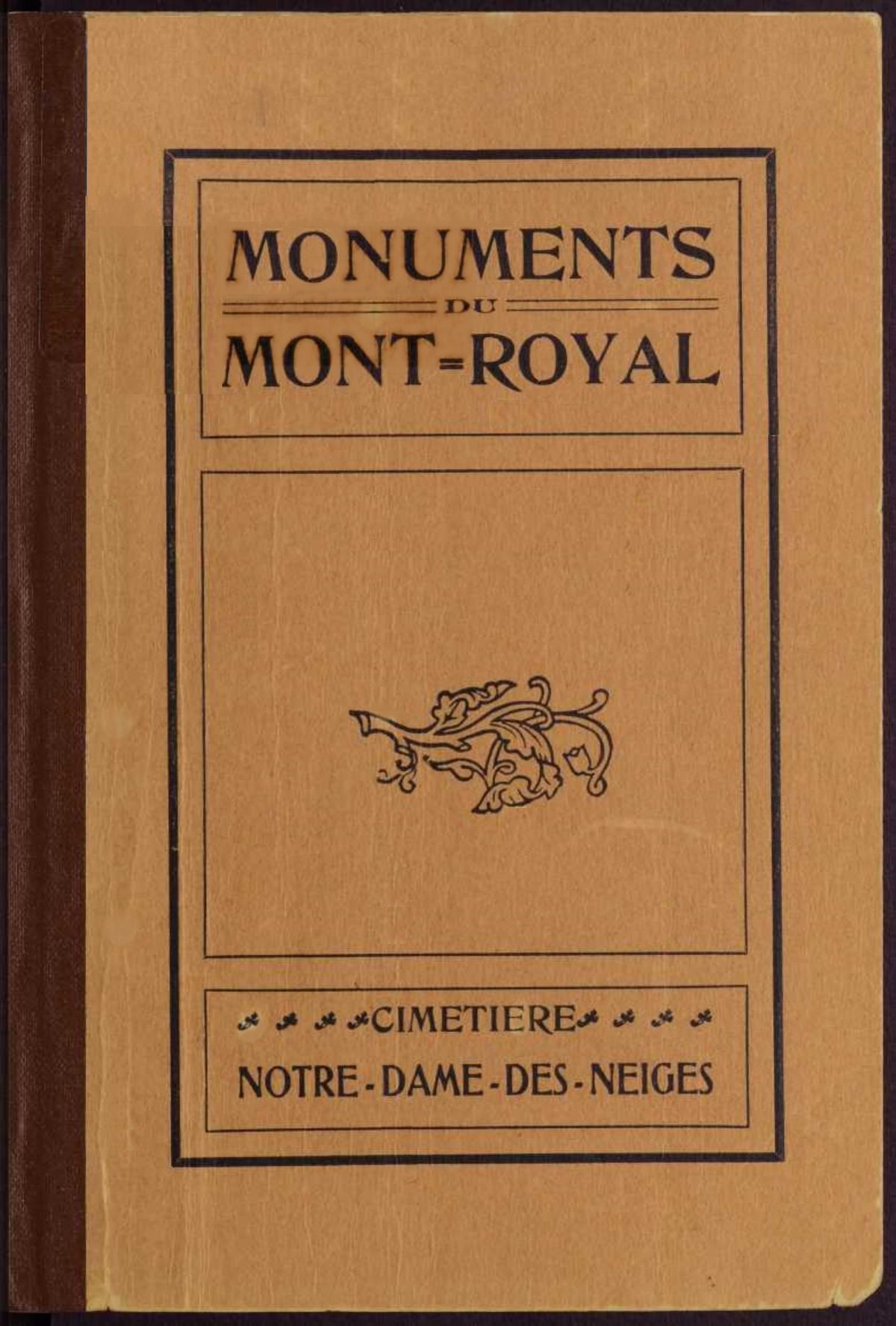
Notre-Dame-des-Neiges Cemetery Montreal: Visiting Hours, Tickets, and Historical Significance
Date: 14/06/2025
Introduction
Nestled on the verdant slopes of Mount Royal, the Notre-Dame-des-Neiges Cemetery stands as Canada’s largest cemetery and a cornerstone of Montreal’s religious, social, cultural, and ecological heritage. Established in 1854 to serve the city’s burgeoning Catholic population, the cemetery has since evolved into a living record of Montreal’s diverse communities and their histories. Its landscape, inspired by the 19th-century rural cemetery movement, harmoniously blends art, architecture, and nature, offering a tranquil refuge for reflection and remembrance (Official Site; Parks Canada).
With over 343 acres and more than one million interments, Notre-Dame-des-Neiges is not only a sacred resting place but also a vast open-air museum. Gothic Revival entrances, neoclassical mausoleums, and monuments by renowned Quebec artists dot the grounds, which are further distinguished by dedicated sections for various ethnic communities—testament to Montreal’s multicultural Christian heritage (Lonely Planet; Cemetery Official Site).
Beyond its historical and cultural value, Notre-Dame-des-Neiges is a champion of urban biodiversity. Its Green Plan promotes sustainable landscaping, eco-friendly burial options, and stewardship of Mount Royal’s natural environment (cimetierenotredamedesneiges.ca; markets.businessinsider.com).
This guide offers detailed insights into the cemetery’s history, architecture, ecological initiatives, visiting information—including hours, tickets, and accessibility—and nearby Montreal attractions. Whether your interests lie in history, genealogy, art, spirituality, or nature, this resource will help you plan a rewarding visit to one of Montreal’s most unique landmarks (Official Site; Wikipedia).
Table of Contents
- Introduction
- Historical Foundations and Development
- Architectural Significance and Landscape Design
- Religious Significance
- Social and Cultural Importance
- Environmental and Ecological Commitment
- Practical Visitor Information
- FAQs
- Conclusion
- References
Historical Foundations and Development
Notre-Dame-des-Neiges Cemetery was founded in 1854, responding to the urgent need for burial space for Montreal’s expanding Catholic community. Its establishment was part of a broader public health and urban planning movement, which advocated relocating cemeteries from crowded city centers to more serene, rural settings (Official Site). The selection of Mount Royal’s slopes provided a setting that was both picturesque and symbolically elevated, reflecting Catholic traditions of situating sacred spaces on high ground.
Influenced by the rural cemetery movement exemplified by Mount Auburn (Massachusetts) and Père Lachaise (Paris), Notre-Dame-des-Neiges was designed to resemble a landscaped park, with winding paths, mature trees, and carefully planned vistas. Over time, it expanded to its current 343 acres, becoming the largest cemetery in Canada and the third-largest in North America.
The cemetery has continually adapted to meet the needs of Montreal’s changing demographics, with sections dedicated to various religious orders, ethnic communities, and professional groups. Its grounds are the final resting place for a cross-section of Montreal society, including political leaders, artists, and everyday citizens.
Architectural Significance and Landscape Design
Layout and Rural Cemetery Movement
Notre-Dame-des-Neiges is a classic example of the 19th-century rural cemetery movement. Its design encourages visitors to stroll along curving roads lined by mature trees and ornamental shrubs, creating a peaceful environment for remembrance and contemplation. The checkerboard layout, developed by Henri-Maurice Perrault, harmonizes with Mount Royal’s natural contours and French formal traditions (Parks Canada).
Notable Structures and Monuments
- Main Entrance and Gatehouse: The striking wrought-iron gates and gatehouse on Côte-des-Neiges Road feature Gothic Revival and Romanesque elements.
- Mausoleums and Chapels: Notable examples include the Chapel of the Resurrection and several family mausoleums constructed in neoclassical and art deco styles. The mausoleums—such as Notre Dame (1978), John-Paul II (1980), Saint-Francis (1982), Marguerite-Bourgeoys (1983), and The Pietà (1985)—showcase a range of funerary art (Wikipedia).
- Columbaria: Modern columbaria for cremation urns are thoughtfully integrated within the historic landscape.
- Monuments and Statuary: The grounds are adorned with sculptures and memorials, including works by Louis-Philippe Hébert, Henri Hébert, and Émile Brunet, as well as memorials to the Patriotes and other significant figures.
Artistic and Cultural Heritage
Notre-Dame-des-Neiges is an open-air museum of funerary art, with monuments featuring marble, granite, bronze, mosaics, and religious iconography. The variety of styles and languages reflects the multicultural evolution of Montreal’s Catholic and immigrant communities (Cemetery Official Site).
Religious Significance
Catholic Heritage and Symbolism
As Canada’s largest Catholic cemetery, Notre-Dame-des-Neiges was established around key Catholic doctrines, including the belief in bodily resurrection and the sanctity of burial. Its elevated location on Mount Royal symbolizes spiritual ascension. Crosses, angels, and biblical motifs are prevalent throughout the grounds, and the Notre-Dame-de-la-Résurrection Chapel remains a center for religious ceremonies (Parks Canada).
Multidenominational Adaptation
While originally Catholic, the cemetery now includes dedicated sections for various Christian communities—Chinese, Japanese, Ukrainian, Polish, Italian, Portuguese, Serbian, and more—each expressing unique traditions through language, iconography, and funerary art (Cemetery Official Site).
Social and Cultural Importance
Community and National Memory
Home to more than one million interments, Notre-Dame-des-Neiges is a chronicle of Montreal’s social fabric. Interred here are notable figures such as Calixa Lavallée, composer of “O Canada,” several former mayors, and Titanic disaster victims. The Répertoire des personnages inhumés au Cimetière provides detailed biographical information for research and genealogy (Cemetery Official Site; Lonely Planet).
Sections organized by families, ethnic groups, or professional associations—such as the Firefighters Association and the Canadian Army—underscore the cemetery’s role in strengthening community identity. Annual events like memorial masses and All Souls’ Day commemorations further reinforce this sense of collective memory.
Multiculturalism and Inclusion
Notre-Dame-des-Neiges mirrors Montreal’s multicultural character. Distinct sections reflect the traditions of French, Italian, Chinese, Ukrainian, and other communities, creating a vibrant cultural mosaic within the tranquil landscape (Cemetery Official Site).
Artistic and Architectural Heritage
The cemetery’s artistic value is highlighted by exceptional monuments and historic buildings—such as the administrative pavilion and Simon-Lacombe House—recognized for their heritage importance at all governmental levels.
Environmental and Ecological Commitment
The Green Plan and Biodiversity
Notre-Dame-des-Neiges is a biodiversity haven, with over 13,500 trees and nearly 100 wildlife species. The 2021 Green Plan was developed with extensive community input and guidance from environmental experts, aiming to reduce the cemetery’s ecological footprint and protect Mount Royal’s natural environment (cimetierenotredamedesneiges.ca; markets.businessinsider.com).
Key initiatives include:
- Transforming lawns into pollinator-friendly meadows.
- Creating ecological corridors for wildlife.
- Implementing a strict no-pesticide policy.
- Collaborating with Leave No Trace Canada to promote sustainable visitor practices.
Eco-Friendly Burial Options
The cemetery offers eco-friendly burials, such as the Remembrance Grove, where ashes are interred beneath native trees. These options minimize environmental impact and support urban forest renewal (cimetierenotredamedesneiges.ca; fabriquenotredame.ca).
Waste Reduction and Resource Management
Sustainability efforts include waste reduction, recycling, and resource management. Visitors are encouraged to manage their own waste and support recycling, and the cemetery provides up-to-date maps showing maintenance activities (markets.businessinsider.com).
Practical Visitor Information
Location, Hours, and Accessibility
- Address: 4601 Chemin de la Côte-des-Neiges, Montreal, Quebec, H3V 1E7 (official site).
- Visiting Hours: Daily, 8:00 AM to 5:00 PM (mausoleums 8:00 AM to 4:00 PM). Administrative offices open Tuesday to Friday, 8:00 AM to 4:30 PM (closed Mondays and weekends; lunch 12:00 PM–1:00 PM).
- Accessibility: Wheelchair-accessible paths, ramps, and designated parking. Some areas are hilly; plan accordingly.
- Public Transit: Accessible via Metro (Édouard-Montpetit station), bus lines 165 and 166, and on-site parking.
Tickets, Tours, and Etiquette
- Admission: Free for general visits; some guided tours or special events may require advance registration and a fee.
- Guided Tours: Available seasonally in English and French; check the official website for schedules.
- Etiquette: Maintain respectful conduct. Photography for personal use is permitted but should be discreet, especially during ceremonies. Professional or commercial photography requires prior authorization.
Navigating the Grounds
- Obtain a map at the visitor center or download from the cemetery’s website.
- Use the computerized mapping system (on-site or online) to locate specific graves and monuments (Wikipedia).
- Benches and shaded areas are available for rest. Wear comfortable shoes and prepare for varied terrain.
Amenities
- Public restrooms and drinking fountains are available near administrative offices and along main paths.
- Parking is available near the main entrance.
Nearby Montreal Attractions
- Mount Royal Park: Urban park with trails and scenic viewpoints.
- Saint Joseph’s Oratory: Major pilgrimage site with impressive architecture.
- Beaver Lake & Mount Royal Chalet: Ideal for relaxation and city views.
- Other Cemeteries: Mount Royal Cemetery and Shaar Hashomayim Cemetery nearby.
- Côte-des-Neiges Road: Cafés, restaurants, and transit options (Trip.com).
Virtual Resources
- The cemetery’s website offers virtual tours, interactive maps, and high-quality images of the grounds (official site).
Frequently Asked Questions (FAQs)
Q: What are the visiting hours?
A: Daily, 8:00 AM to 5:00 PM. Mausoleums close at 4:00 PM. Check the official website for any updates.
Q: Is there an admission fee?
A: No, general admission is free. Guided tours or special events may require tickets.
Q: Are guided tours available?
A: Yes, guided tours are offered seasonally in English and French. Audio guides and brochures are also available.
Q: Is the cemetery wheelchair accessible?
A: Yes, most areas have paved paths and ramps, though some terrain is hilly.
Q: Can I take photographs?
A: Personal photography is allowed if done respectfully. Professional photography requires permission.
Q: How do I find a specific grave?
A: Use the on-site or online computerized mapping system to search and locate graves.
Conclusion
Notre-Dame-des-Neiges Cemetery is much more than a burial ground—it is a vital part of Montreal’s historical, artistic, and ecological landscape. Its blend of religious symbolism, multicultural community sections, artistic monuments, and ecological stewardship make it a place of profound significance and serene beauty. Free admission, accessible facilities, and guided tours ensure that all visitors can experience its legacy.
Plan your visit by consulting the official website for current hours, tours, and special events. Enhance your exploration with the Audiala app for guided audio tours. Whether you seek history, art, genealogy, or quiet contemplation, Notre-Dame-des-Neiges Cemetery offers a unique and meaningful Montreal experience (Official Site; Audiala app).
References
- Notre-Dame-des-Neiges Cemetery Official Site
- Parks Canada: National Historic Site Description
- Notre-Dame-des-Neiges Cemetery: Ecology and Biodiversity
- Wikipedia: Notre-Dame-des-Neiges Cemetery
- Lonely Planet: Notre-Dame-des-Neiges Cemetery
- Markets Insider: Ecological Shift at Notre-Dame-des-Neiges Cemetery
- Trip.com: Notre-Dame-des-Neiges Cemetery
